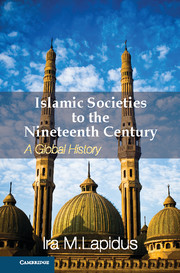Book contents
- Frontmatter
- Contents
- List of Illustrations
- List of Figures
- List of Maps
- List of Tables
- Preface
- Acknowledgments
- Acknowledgments to the first edition of A History of Islamic Societies
- Acknowledgments to the second edition of A History of Islamic Societies
- Publisher's Preface
- Introduction to Islamic Societies
- Part I The Beginnings of Islamic Civilizations
- Part II From Islamic Community to Islamic Society
- Egypt, Iraq, and Iran, 945–C. 1500
- Chapter 20 The Post-ʿAbbasid Middle Eastern State System
- Chapter 21 Muslim Communities and Middle Eastern Societies: 1000–1500 CE
- Chapter 22 The Collective Ideal
- Chapter 23 The Personal Ethic
- Chapter 24 Conclusion: Middle Eastern Islamic Patterns
- Part III The Global Expansion of Islam from the Seventh to the Nineteenth Centuries
- Glossary
- Bibliography
- Annotated Bibliography from A History of Islamic Societies, 2nd Edition
- Index
Chapter 24 - Conclusion: Middle Eastern Islamic Patterns
Published online by Cambridge University Press: 05 February 2013
- Frontmatter
- Contents
- List of Illustrations
- List of Figures
- List of Maps
- List of Tables
- Preface
- Acknowledgments
- Acknowledgments to the first edition of A History of Islamic Societies
- Acknowledgments to the second edition of A History of Islamic Societies
- Publisher's Preface
- Introduction to Islamic Societies
- Part I The Beginnings of Islamic Civilizations
- Part II From Islamic Community to Islamic Society
- Egypt, Iraq, and Iran, 945–C. 1500
- Chapter 20 The Post-ʿAbbasid Middle Eastern State System
- Chapter 21 Muslim Communities and Middle Eastern Societies: 1000–1500 CE
- Chapter 22 The Collective Ideal
- Chapter 23 The Personal Ethic
- Chapter 24 Conclusion: Middle Eastern Islamic Patterns
- Part III The Global Expansion of Islam from the Seventh to the Nineteenth Centuries
- Glossary
- Bibliography
- Annotated Bibliography from A History of Islamic Societies, 2nd Edition
- Index
Summary
What we now classify as a Middle Eastern Islamic civilization is actually the by-product of a process that occupied six hundred years, from the beginning of the seventh to the beginning of the thirteenth centuries. However innovative, Islamic civilization was constructed on a framework of institutions and cultures inherited from the ancient Middle East. On the eve of the Islamic era, Middle Eastern societies were organized on several levels. At the base, there were numerous local, parochial communities built around factional, lineage, tribal, and village groups. These communities were integrated by market exchanges and by great religious associations – Jewish, Christian, or Zoroastrian. The larger-scale economic networks and religious associations were in turn under the rule of the Byzantine and Sasanian empires. On the cultural level, the ancient heritage included the monotheistic religions, imperial arts and literatures, and philosophy and science. This complex institutional and cultural heritage was carried over into the Islamic era. Despite the rise and fall of empires and shifts in economic activity, the fundamental aspects of technology, modes of production, and the relation of human communities to the natural environment continued unaltered. Also, the basic modes of state organization and family and religious association remained the same. The characteristic changes of the Islamic era were the formation of new political and social identities, the organization of new religious communities, and the generation, out of the elements of the past, of a new cultural style.
New political and religious identities for Middle Eastern societies began in Arabia. While under the influence of Byzantine and Sasanian civilizations, Arabia was not fully integrated into the rest of the region. It was basically a lineage society in which the conflicts of lineage and commercial communities and the religious and cultural influences emanating from the rest of the Middle East made possible the emergence of a new prophet, Muhammad, and the revelation of a new religion, Islam. To Muhammad, God revealed a new monotheism, which differed in its specific teachings, eschatological consciousness, and literary qualities from Judaism and Christianity. The Prophet also organized a new community parallel in form to Jewish and Christian religious associations.
- Type
- Chapter
- Information
- Islamic Societies to the Nineteenth CenturyA Global History, pp. 330 - 340Publisher: Cambridge University PressPrint publication year: 2012



